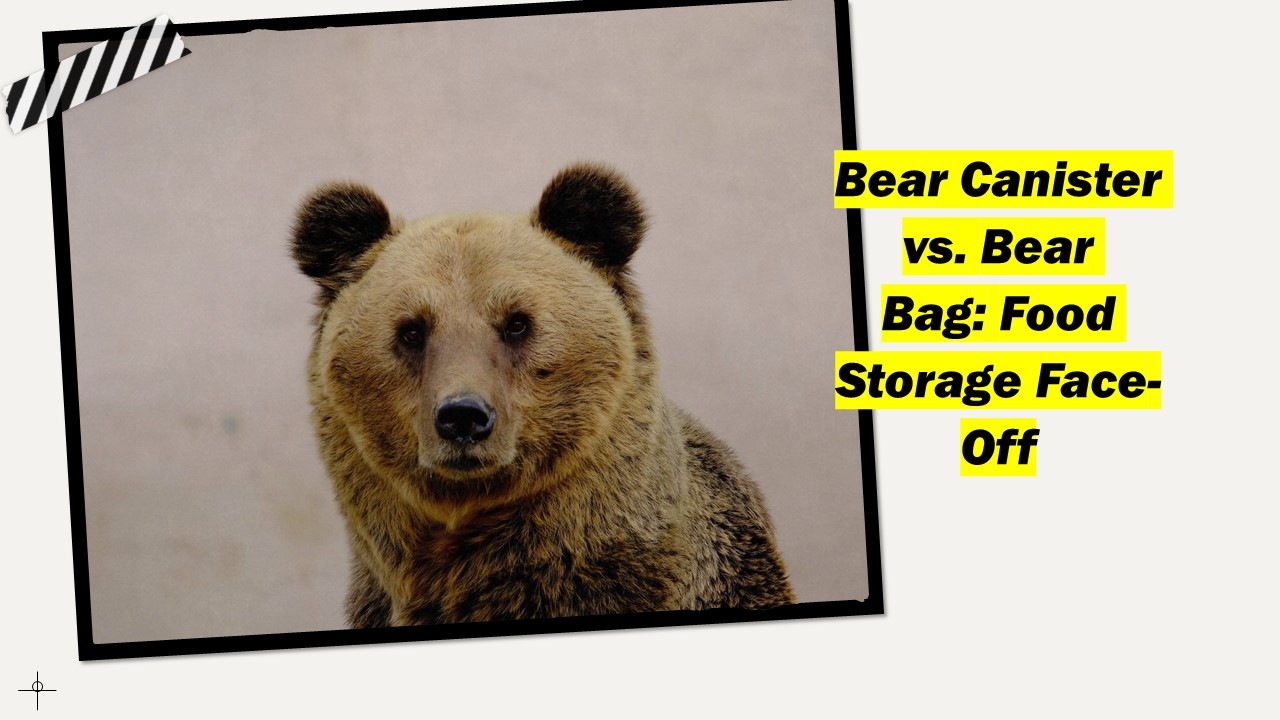In the vast and breathtaking wilderness, where nature’s wonders and untamed creatures thrive, it is crucial for outdoor enthusiasts to be well-prepared and knowledgeable about their surroundings. One of the most important considerations when venturing into bear country is proper food storage. Bears possess a powerful sense of smell and an innate curiosity that can lead them to food sources, including the supplies carried by hikers and campers. To mitigate the risks associated with human-bear encounters and maintain the ecological balance, outdoor adventurers have two popular options for storing their food: bear canisters and bear bags. Which is the better option?
The choice between a bear canister and a bear bag depends on various factors. Bear canisters provide a robust and proven method for protecting food from bears, complying with regulations, and offering peace of mind. Bear bags, on the other hand, offer a lightweight and portable alternative, ideal for shorter trips or areas where hanging is feasible.
However, this comprehensive guide aims to explore and compare these two methods, allowing you to make an informed decision based on their specific needs and the unique challenges they may face in the great outdoors. Let’s get to it!
Understanding Bear Behavior and Food Attraction
Before delving into the specifics of bear canisters and bear bags, it is crucial to grasp the fundamentals of bear behavior and their attraction to food. Bears possess a remarkable sense of smell, estimated to be 2,000 times stronger than that of humans. This heightened olfactory ability allows them to detect food sources from great distances.
Bears are opportunistic omnivores, meaning they have a diverse diet that includes vegetation, insects, small mammals, and occasionally carrion. However, they can also develop an affinity for human food due to its calorie density and palatability. Once bears associate humans with a potential food source, they may become habituated or even aggressive in their pursuit of it.
Bears rely on their senses to locate food, and understanding these senses is vital when considering food storage options. Their sense of smell is the primary tool for detecting food, but they also possess acute hearing and excellent visual memory.
When choosing between bear canisters and bear bags, it is essential to recognize that both options aim to minimize the potential for bears to detect and access food. By obstructing the scent of food, these storage methods reduce the likelihood of attracting bears to campsites and hiking trails.
Responsible food storage plays a crucial role in minimizing human-bear encounters and promoting the safety of both humans and bears. By preventing bears from accessing human food, we can help maintain their natural foraging behaviors and reduce the risk of aggressive bear behavior.
Using appropriate food storage methods not only safeguards the well-being of humans but also protects the lives of bears. Human-bear conflicts often result in the relocation or euthanization of bears, which disrupts their ecological role and threatens their long-term survival.
Bear Canisters
Bear canisters are specially designed containers used for storing food and scented items securely in bear country. These rigid, bear-resistant canisters are constructed from robust materials such as polycarbonate or hard plastic, making them extremely durable and resistant to bear tampering.
The primary purpose of bear canisters is to create a physical barrier that prevents bears from accessing the stored food. These containers are designed to withstand the strength and ingenuity of bears, keeping both humans and wildlife safe.
Features and Construction of Bear Canisters
- Material and Durability: Bear canisters are typically made from high-strength materials such as polycarbonate or hard plastic, ensuring their durability and resistance to bear-related damage. These materials are also lightweight, which is advantageous for backpackers and hikers.
- Capacity and Weight Considerations: Bear canisters come in various sizes and capacities, allowing users to choose based on the length and nature of their trip. It is important to consider both the amount of food required and the available space in a backpack. However, bear canisters can be bulkier and heavier compared to other storage options.
- Locking Mechanisms and Bear Resistance: Bear canisters employ robust locking mechanisms, typically consisting of interlocking lids or screw-top closures, which make it difficult for bears to open them. These mechanisms are designed to withstand bear strength and dexterity, ensuring the contents remain secure.
Advantages of Using Bear Canisters
- Effective Barrier Against Bears: Bear canisters provide a reliable and proven method of preventing bears from accessing stored food. Their robust construction and bear-resistant locking mechanisms make them highly effective in deterring bears’ attempts to open or damage the container.
- Compliance with Wilderness Regulations: Many wilderness areas and national parks have specific regulations mandating the use of bear canisters for food storage. By utilizing bear canisters, outdoor enthusiasts can ensure compliance with these regulations and help protect the natural environment.
- Protection for Food and Personal Safety: Bear canisters not only safeguard food from bears but also protect against other critters like raccoons or rodents. Additionally, by keeping food stored safely away from campsites, the risk of attracting bears and potential human-bear encounters is significantly reduced, ensuring personal safety.
Limitations and Challenges of Bear Canisters
- Bulky and Heavy for Extended Trips: Due to their rigid structure and robust construction, bear canisters can be bulkier and heavier compared to other food storage options. This can pose challenges for backpackers embarking on extended trips with limited carrying capacity.
- Limited Storage Space: The storage space within a bear canister is finite, and it may be challenging to fit all necessary food and scented items, especially for longer trips or larger groups. Proper meal planning and strategic packing are essential to maximize the available space.
- Cost Considerations: Bear canisters, especially those meeting industry standards and regulations, can be relatively expensive compared to other food storage methods. However, considering their effectiveness in bear country and potential fines for non-compliance, they are a worthwhile investment for safety and environmental conservation.
Can bears smell through a bear canister?
No, bears cannot smell through a properly sealed bear canister. Bear canisters are designed to create an airtight seal, preventing odors from escaping and masking the scent of food stored inside. The robust construction and locking mechanisms of bear canisters make them highly effective at deterring bears from accessing the contents. However, it’s important to ensure that the canister is closed tightly and stored away from your sleeping area to minimize any potential scent detection by curious bears.
Bear Bags
Bear bags, also known as food hanging bags or bear hangs, are lightweight and portable alternatives to bear canisters for storing food and scented items in bear country. These bags are typically made of durable nylon or similar materials that are resistant to bear tampering.
The primary purpose of bear bags is to suspend food and scented items high off the ground and away from bears’ reach. By hanging the bag from a tree branch or other suitable anchor point, it creates a physical barrier that deters bears from accessing the food.
Features and Construction of Bear Bags
- Material and Durability: Bear bags are constructed from durable and tear-resistant materials such as nylon, ensuring their longevity and ability to withstand environmental conditions. The material should be sturdy enough to prevent bears from ripping or tearing the bag.
- Hanging Systems and Techniques: Bear bags often come equipped with suspension systems, including ropes, cords, or carabiners, that facilitate the hanging process. These systems allow users to hoist the bag high above the ground and out of reach of bears. Proper hanging techniques, such as the PCT method or counterbalance method, are essential for maximum effectiveness.
- Bear Resistance Measures: While bear bags are not entirely bear-proof, they incorporate features that discourage bears from accessing the contents. This may include odor-resistant materials or additional deterrents like small bells or reflective tape that can startle bears and deter them from approaching.
Advantages of Using Bear Bags
- Lightweight and Portable Option: Bear bags are lightweight and take up minimal space in a backpack. This makes them an attractive option for backpackers and hikers who prioritize minimizing weight and maximizing mobility on their outdoor adventures.
- Versatility in Hanging Locations: Bear bags offer flexibility in terms of hanging locations. As long as there are suitable anchor points, such as tree branches or designated bear poles, users can hang their bags to create a safe distance between the food and bears. This adaptability is particularly useful in areas where bear canister regulations may not apply.
- Cost-Effective Solution: Bear bags are generally more affordable than bear canisters, making them an economical choice for those on a budget or for occasional outdoor trips.
Limitations and Challenges of Bear Bags
- Reliance on Proper Hanging Techniques: The effectiveness of bear bags heavily relies on proper hanging techniques. Inadequate or incorrect hanging can compromise the security of the food and potentially attract bears. It is essential to educate oneself on proper hanging methods and practice them diligently.
- Potential for Human Error: While bear bags are effective when used correctly, user error can lead to compromised food storage. Neglecting to hang the bag at an adequate height, improper knot tying, or insufficient distance from the trunk can increase the risk of bears accessing the food.
- Bear Persistence and Potential Failures: Although bear bags are designed to deter bears, persistent and determined bears may still attempt to access the food. Some bears have become skilled at manipulating hanging systems or even breaking tree branches to reach suspended bags. While such instances are rare, they highlight the importance of vigilance and regular monitoring.
So, do bear bags actually work?
Yes, bear bags can be effective when used properly. Bear bags are designed to hang food and scented items high off the ground and away from bears’ reach. When properly hung, bear bags create a physical barrier that deters bears from accessing the food. The key to their effectiveness lies in following proper hanging techniques, such as the PCT method or counterbalance method, and selecting suitable anchor points.
Additionally, using odor-resistant bags and taking precautions to minimize odors can further enhance their effectiveness. While bear bags are not entirely bear-proof and determined bears may attempt to access them, when used correctly, bear bags can significantly reduce the risk of attracting bears to your campsite and help protect both humans and bears.
Factors to Consider When Choosing Between Bear Canisters and Bear Bags
When deciding between bear canisters and bear bags for food storage in bear country, it is crucial to consider several factors to ensure the most suitable choice for your outdoor adventure. By carefully evaluating these factors, you can make an informed decision that prioritizes safety, convenience, and compliance with regulations.
- Regulations and Requirements of the Area: Familiarize yourself with the specific regulations and requirements of the wilderness area or national park you plan to visit. Some areas may mandate the use of bear canisters, while others may allow bear bags or have no specific requirements. Ensure compliance with these regulations to protect the environment and avoid potential penalties.
- Duration and Type of Outdoor Trip: Consider the length and nature of your outdoor trip. For shorter trips or day hikes, a bear bag may provide sufficient storage capacity while keeping weight and bulk to a minimum. However, for extended trips or group outings that require more food and longer storage durations, a bear canister’s larger capacity may be advantageous.
- Hiking Conditions and Accessibility: Evaluate the hiking conditions and accessibility of the area you plan to explore. Bear canisters are advantageous in areas with rough terrain, rocky landscapes, or no suitable trees for hanging bear bags. On the other hand, if the terrain allows for secure and proper hanging of bear bags, they can be a viable option.
- Personal Preferences and Prior Experience: Consider your personal preferences and past experiences. If you have prior experience using either bear canisters or bear bags and feel confident in your abilities to use them effectively, that may influence your choice. Some individuals may prefer the simplicity and familiarity of one method over the other.
- Weight and Space Considerations: Assess the weight and space limitations of your backpack. Bear canisters are typically bulkier and heavier compared to bear bags. If minimizing weight and maximizing space are priorities for your outdoor adventure, a bear bag may be a more suitable option.
- Cost and Investment Analysis: Take into account the cost and investment associated with each option. Bear canisters are generally more expensive than bear bags. Consider your budget and the frequency of your outdoor excursions to determine whether the additional investment in a bear canister is justifiable.
In the following section, I will provide expert recommendations and best practices for responsible food storage in bear country.
Expert Recommendations and Best Practices
When it comes to responsible food storage in bear country, following expert recommendations and best practices is crucial for promoting safety, minimizing human-bear encounters, and protecting both humans and bears. Consider the following recommendations:
- Carry out Extensive Research and Check Local Regulations: Before embarking on your outdoor adventure, conduct thorough research on the specific regulations and requirements of the area you plan to visit. Familiarize yourself with the guidelines and restrictions regarding food storage, whether it mandates bear canisters, allows bear bags, or has other specific requirements.
- Consider the Specifics of Your Trip and Location: Take into account the duration, type, and conditions of your outdoor trip. Evaluate factors such as the length of your journey, the availability of suitable hanging trees, the terrain, and the likelihood of encountering bears. These factors will help guide your choice between bear canisters and bear bags.
- Understand Proper Techniques for Bear Canister Usage: If you opt for bear canisters, educate yourself on the proper techniques for their usage. This includes correctly securing the lid or closure mechanism, ensuring a tight seal to prevent odors from escaping, and familiarizing yourself with any specific instructions provided by the manufacturer.
- Master the Art of Hanging a Bear Bag: If you choose bear bags as your preferred method, it is essential to learn and practice proper hanging techniques. Familiarize yourself with methods such as the PCT method or counterbalance method. Practice your knot-tying skills, ensure sufficient height and distance from the trunk, and consider using odor-resistant bags to further deter bears.
- Seek Advice from Experienced Outdoor Enthusiasts or Park Rangers: Engage with experienced outdoor enthusiasts or seek advice from park rangers who are knowledgeable about the specific area you plan to explore. They can provide valuable insights, share their experiences, and offer recommendations based on their expertise.
- Trustworthy Brands and Products in the Market: Invest in high-quality, bear-resistant products from reputable brands. Look for bear canisters and bear bags that meet industry standards and have a proven track record of bear resistance. This ensures that the equipment you use is reliable, durable, and capable of effectively deterring bears.
Implementing these guidelines will help mitigate the risks associated with human-bear encounters, protect wildlife, and foster a safer and more harmonious coexistence in the wilderness.
Conclusion
In the vast expanse of the outdoors, where bears roam and nature thrives, responsible food storage is paramount. Choosing between bear canisters and bear bags requires careful consideration of factors such as regulations, trip specifics, personal preferences, weight constraints, and cost analysis.
Bear canisters provide a robust barrier against bears, ensuring the safety of both humans and wildlife. On the other hand, bear bags offer lightweight and portable alternatives that can be effective when proper hanging techniques are employed.
By following expert recommendations, educating yourself on bear behavior, understanding the features and advantages of each method, and considering the specific factors at play, you can make an informed decision that prioritizes safety, compliance, and harmonious coexistence with bears in their natural habitat.
You might be also interested in reading: How Far Away Can Raccoons Smell Food?










